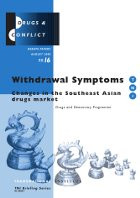Ideas into movement
Boost TNI's work
50 years. Hundreds of social struggles. Countless ideas turned into movement.
Support us as we celebrate our 50th anniversary in 2024.

This TNI briefing aims at contributing to a better understanding of current market dynamics in Southeast Asia, essential for designing more effective and sustainable policy responses consistent with human rights and harm reduction principles.

Opium production in Southeast Asia has decreased significantly in the past decade. There is little reason for optimism, however. The decline has not reduced the supply of opium and heroin on the global market and there are serious questions about its sustainability. The abrupt decline has caused untold misery for opium farmers in the region, who do not yet have sufficient alternatives livelihoods in place. The situation is further complicated by acute land shortages exacerbated by Chinese investment in plantations in the region. Meanwhile, current levels of development assistance for Burma and Laos remain low.
The decline has led users to shift from smoking opium to injecting heroin, significantly contributing to the HIV/AIDS epidemic in the region. Now signs are that the quality of heroin is declining while the price is increasing causing drug users to experiment with pharmaceutical cocktails. The new health risks are not yet known.
There is an urgent need to harmonize drug policies with HIV policies. Long-term support for harm reduction and health care programmes for drug users must be prioritised. Only a small proportion of intravenous drug users in need of harm reduction programmes have access to services. Sentences for minor drug offences are disproportionately high and need to be reviewed. Repressive legislation that criminalizes drug users further hampers access to treatment and prevention services.
The international community should not abandon (former) opium growing communities and drugs users at this critical stage of market changes in the Golden Triangle. National and local authorities in the region need to realise that these are complicated issues and there can be no quick fixes and onesize-fits-all solutions for drug-related problems.
This TNI briefing aims at contributing to a better understanding of current market dynamics in Southeast Asia, essential for designing more effective and sustainable policy responses consistent with human rights and harm reduction principles.
Pages: 40